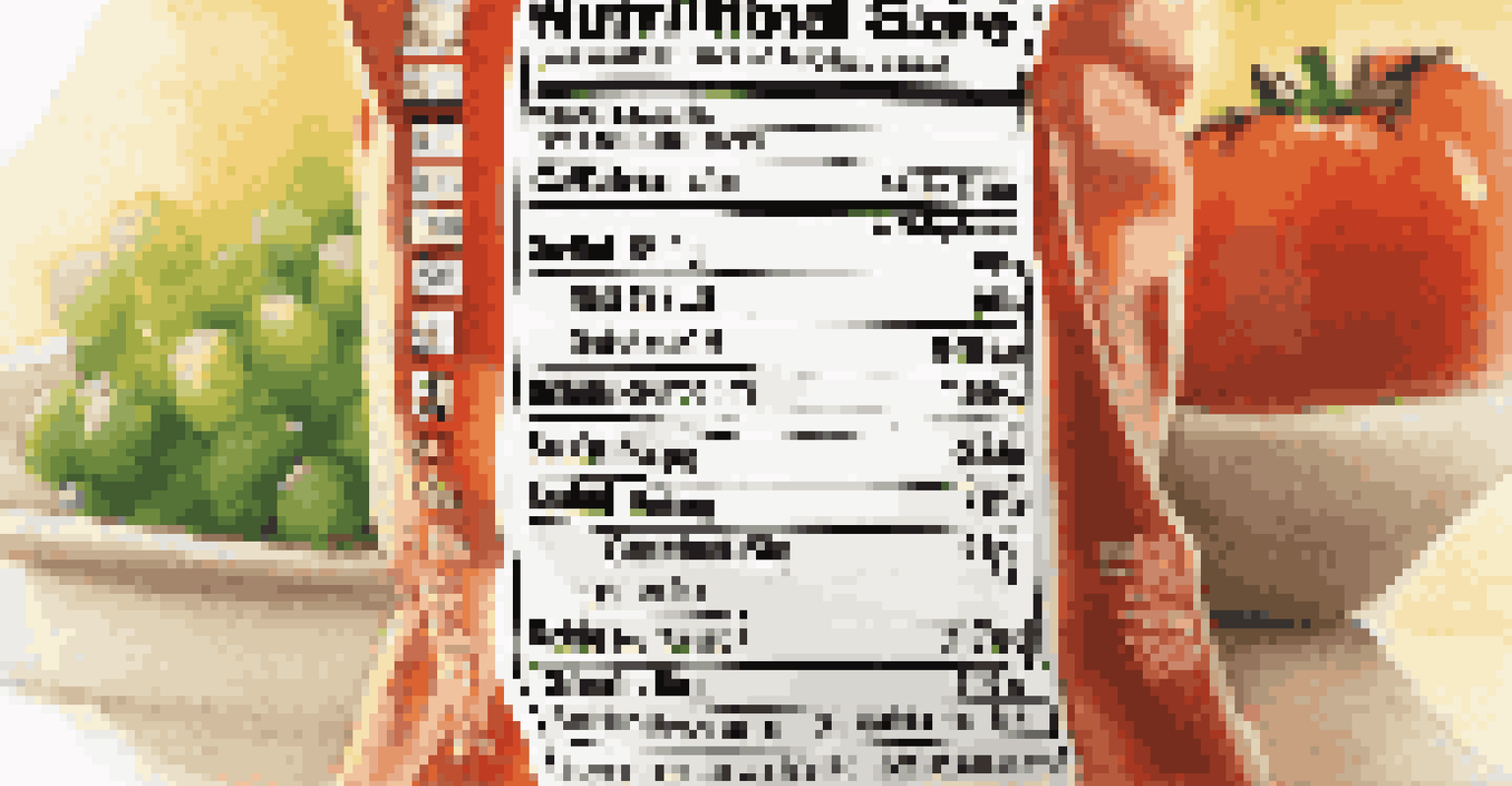Understanding Food Labels: Making Informed Dietary Choices

The Importance of Reading Food Labels
Food labels are more than just regulatory requirements; they serve as a guide for making healthier dietary choices. By understanding what’s in our food, we can better align our eating habits with our health goals. Ignoring these labels can lead to unintended consumption of excess calories, sugars, and unhealthy fats.
Knowing what you put in your body is the first step to making healthier choices.
Consider grocery shopping like reading a map—food labels help navigate your way to healthier options. For example, knowing how to spot hidden sugars or unhealthy fats can turn a potentially poor choice into a smart one. This knowledge empowers you to take control of your nutrition.
Ultimately, reading food labels can be a game changer in your health journey. It’s not just about making one good choice; it’s about cultivating lifelong habits that support your overall well-being.
Deciphering Nutritional Information
At first glance, nutritional information can feel overwhelming, but it’s quite straightforward once you break it down. The key components include serving size, calories, and nutrient breakdown. Understanding these elements helps you gauge how a food fits into your daily dietary needs.

For instance, if a snack food has a serving size of 100 calories but you consume double that, you’re looking at 200 calories. By keeping track of serving sizes, you can avoid mindless eating and stick to your nutrition goals. This is where awareness becomes your ally.
Unlock Health with Food Labels
Reading food labels empowers you to make healthier dietary choices by helping you understand what’s in your food.
Moreover, familiarizing yourself with common nutrients like protein, fiber, and sugars can help you make better choices. It’s all about finding balance; for example, choosing a snack high in fiber can keep you fuller longer, making it easier to resist less healthy options.
Understanding Ingredients Lists
The ingredients list is like the behind-the-scenes story of your food—revealing what really goes into it. Ingredients are listed in descending order by weight, meaning the first few items are the most significant components. This can help you identify healthy versus unhealthy staples in your food.
The food you eat can be either the safest and most powerful form of medicine or the slowest form of poison.
For example, if you see whole grains listed as the first ingredient, that’s a positive sign. On the other hand, if sugar, high fructose corn syrup, or artificial flavors top the list, you may want to reconsider. It’s about choosing foods that align with your health values.
Additionally, learning to recognize certain terms can make a big difference. Words like 'organic' or 'natural' can be misleading, so it’s essential to research and understand what they truly mean in the context of food labeling.
Identifying Healthy Fats and Sugars
Fats and sugars often get a bad rap, but not all of them are created equal. Healthy fats, such as those found in avocados and nuts, are essential for your body and can even promote heart health. The key is to differentiate between healthy and unhealthy fats listed on food labels.
When it comes to sugars, it’s crucial to recognize added sugars versus naturally occurring sugars. A food item might list natural sugars from fruits, which are generally healthier, while added sugars contribute to empty calories. Understanding these distinctions can empower you to make better dietary choices.
Portion Control Matters
Being aware of serving sizes on food labels is crucial for managing portion control and maintaining a healthy weight.
By focusing on foods with healthy fats and limiting added sugars, you can enhance your overall nutrition. It’s all about moderation and making informed choices that benefit your health in the long run.
Recognizing Allergens and Special Diets
Food labels are not just about nutrition; they also play a vital role in identifying allergens. Common allergens like nuts, dairy, and gluten are often highlighted, helping individuals with food sensitivities make safer choices. This is particularly important for those with severe allergies, where even trace amounts can pose risks.
For those following specific diets, such as vegan or gluten-free, food labels are indispensable. They can guide you towards options that fit your lifestyle while avoiding excluded ingredients. It’s like having a personal assistant that ensures your dietary needs are met.
Understanding how to read these labels can give you peace of mind and confidence in your meal choices. Always check for allergen statements to ensure that what you're consuming is safe and appropriate for your dietary restrictions.
The Role of Serving Sizes in Portion Control
Serving sizes play a pivotal role in managing portion control, which is crucial for maintaining a healthy weight. Often, we underestimate how much we eat, leading to unintentional weight gain. Food labels provide a standardized reference point to help you make better decisions about your portion sizes.
For example, if a snack bag lists a serving size as 10 chips, but you often eat the whole bag, you may be consuming far more calories than intended. Being mindful of serving sizes can help you enjoy treats without overindulging. It’s about moderation, not deprivation.
Identify Nutritional Values
Deciphering nutritional information and ingredients lists allows you to distinguish between healthy and unhealthy options.
Incorporating this knowledge into your eating habits can lead to a healthier relationship with food. By practicing portion control, you can enjoy a variety of foods while staying aligned with your health objectives.
Making Informed Choices and Building Healthy Habits
Understanding food labels is the first step toward making informed dietary choices. Once you have the knowledge, the next step is applying it consistently in your daily life. Making small, conscious decisions can lead to significant changes over time.
For example, swapping out a sugary drink for water or choosing whole grains over refined ones might seem minor, but these adjustments can significantly impact your health. It’s all about building habits that support your long-term wellness goals.

As you become more comfortable reading labels, you’ll find that your shopping and eating habits improve. This newfound awareness can inspire you to explore new foods and recipes, making the journey to health both exciting and rewarding.